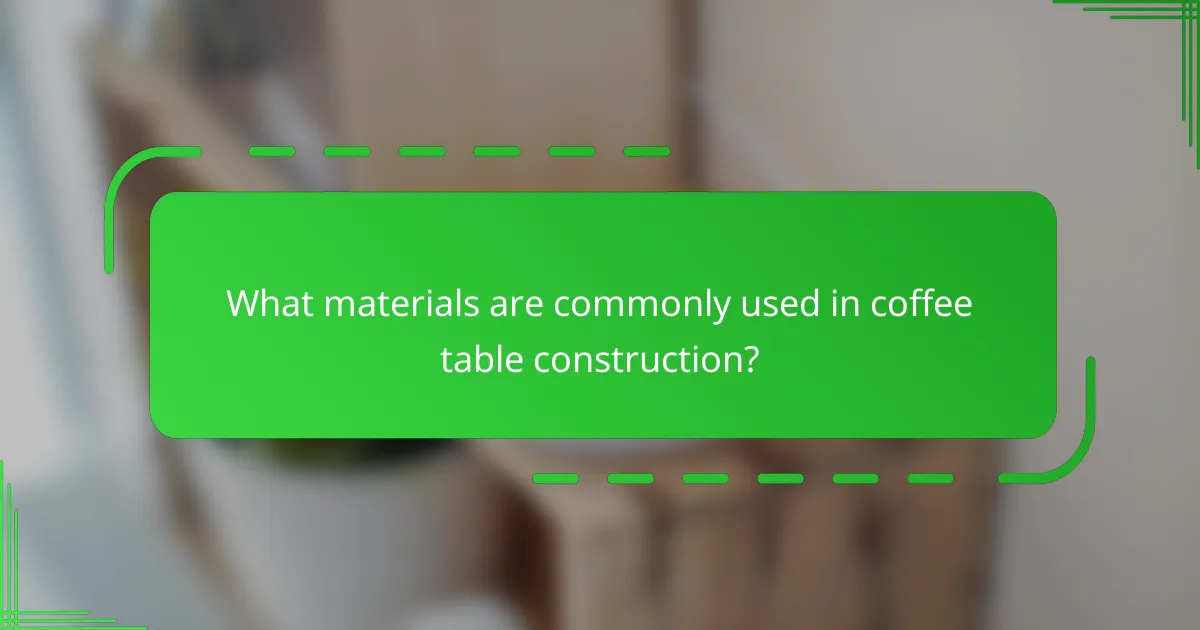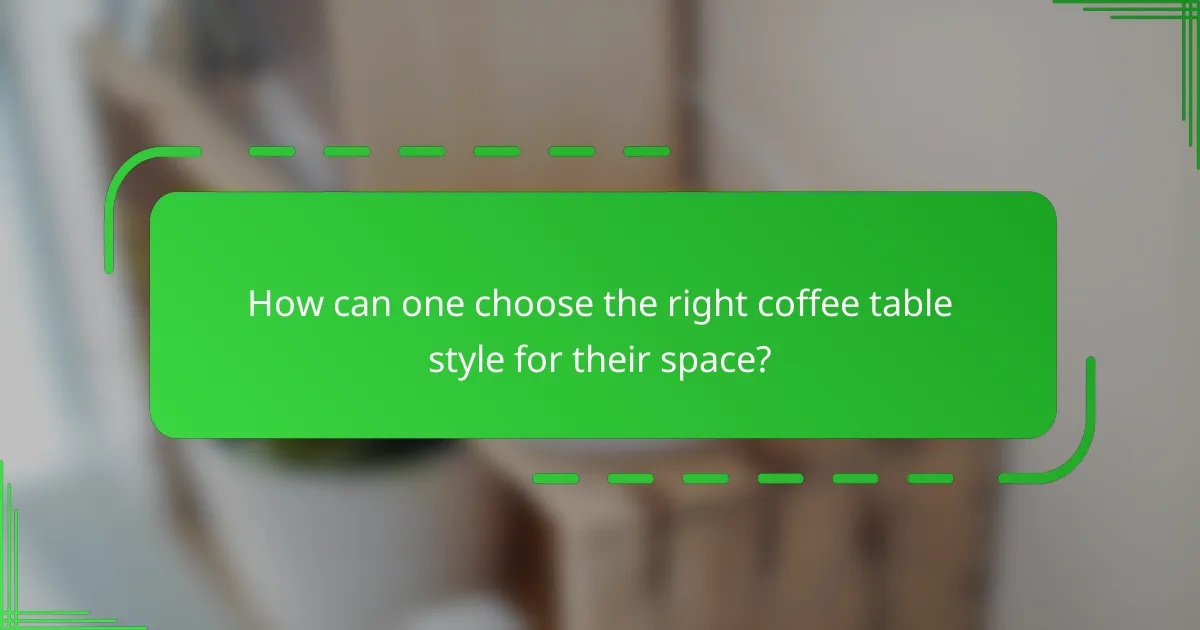Coffee table styles encompass various designs and aesthetics that enhance interior decor, including modern, traditional, rustic, industrial, and mid-century modern. Each style features distinct characteristics, such as sleek lines in modern designs and ornate details in traditional styles. Common materials used in coffee table construction include wood, metal, glass, and stone, each contributing unique attributes to the overall functionality and aesthetic. To select the appropriate coffee table style, factors such as the room’s design theme, available space, height in relation to seating, and personal taste should be considered. Additionally, the shape and storage options of the coffee table play a crucial role in its practicality and integration within the living space.

What are Coffee Table Styles?
Coffee table styles refer to the various designs and aesthetics of coffee tables used in interior decor. Common styles include modern, traditional, rustic, industrial, and mid-century modern. Each style has distinct characteristics that cater to different tastes and preferences. For instance, modern coffee tables often feature sleek lines and minimalistic designs. Traditional styles may include ornate details and classic materials like wood. Rustic coffee tables emphasize natural textures and finishes. Industrial styles incorporate metal and reclaimed wood for a raw look. Mid-century modern tables showcase organic shapes and vibrant colors. These styles influence the overall ambiance of a living space, making them essential in home design.
How do different coffee table styles enhance living spaces?
Different coffee table styles enhance living spaces by adding functionality and aesthetic appeal. A modern glass coffee table creates an illusion of space in small rooms. Rustic wooden tables add warmth and a cozy feel to living areas. Sleek metal designs contribute a contemporary edge and durability. Vintage styles introduce character and history to decor. Multi-functional tables, such as those with storage, optimize space in smaller homes. Each style complements specific interior themes, from minimalist to eclectic. Therefore, the choice of coffee table style directly influences the overall ambiance and usability of a living space.
What are the defining characteristics of popular coffee table styles?
Popular coffee table styles are defined by their design, material, and functionality. Each style serves a unique aesthetic and practical purpose. For instance, modern coffee tables often feature clean lines and minimalist designs. They typically use materials like glass or metal. Rustic styles emphasize natural wood and a handcrafted look. These tables often include distressed finishes for added character. Mid-century modern tables showcase tapered legs and organic shapes. They combine form with function, often incorporating storage options. Industrial styles use raw materials like steel and reclaimed wood. This creates a bold, urban feel. Each style reflects current design trends and personal preferences.
How do coffee table styles reflect personal taste and lifestyle?
Coffee table styles reflect personal taste and lifestyle through their design, material, and functionality. A minimalist coffee table often indicates a preference for simplicity and modern aesthetics. In contrast, a vintage or ornate table may suggest an appreciation for history and craftsmanship. The choice of materials, such as wood, glass, or metal, can signal eco-friendliness or a desire for luxury. Functional aspects, like storage options or multi-use designs, reflect practical lifestyles. Additionally, color and shape preferences can reveal individual personality traits. For example, bold colors may indicate a vibrant personality, while neutral tones suggest a more subdued taste. Overall, coffee tables serve as a focal point in living spaces, showcasing the owner’s unique style and lifestyle choices.
Why is functionality important in coffee table design?
Functionality is crucial in coffee table design because it enhances usability and meets the needs of the space. A well-designed coffee table provides storage and surface area for various activities, such as dining, working, or entertaining. For instance, tables with drawers or shelves can help declutter the living area by storing items like books and remote controls. Additionally, the height and shape of the table should facilitate easy access and movement around the space. Research shows that multifunctional furniture is increasingly preferred in modern homes due to space constraints. According to a study by the American Institute of Architects, 70% of homeowners prioritize functionality in furniture choices. This emphasizes that a coffee table’s design must balance aesthetics with practical use.
What practical uses do coffee tables serve in a home?
Coffee tables serve multiple practical uses in a home. They provide a surface for placing drinks, snacks, and books. This functionality enhances social interactions during gatherings. Coffee tables can also serve as storage units, offering space for magazines or remote controls. Some designs include drawers or shelves for added organization. They can act as a decorative element, contributing to the overall aesthetic of a room. Additionally, coffee tables can be used for games or activities, such as puzzles or board games. Their height and size make them versatile for various living room arrangements. Overall, coffee tables are multifunctional pieces that enhance both utility and style in a home.
How can coffee table functionality influence style choices?
Coffee table functionality significantly influences style choices by determining the design and material selection. Functional aspects include storage capacity, surface area, and versatility. For instance, a coffee table with built-in storage may prioritize a minimalist design to maintain a clean look. Conversely, a large surface area may lead to a more robust and decorative style. Additionally, multifunctional tables, such as those that convert into dining tables, often adopt a modern aesthetic. This trend reflects the growing demand for adaptable furniture in contemporary living spaces. The choice of materials, such as wood or metal, is also influenced by the intended functionality. Durable materials are often selected for tables that will see heavy use. Thus, the functionality of a coffee table directly shapes its overall style and design choices.
What are the latest design trends in coffee tables?
The latest design trends in coffee tables emphasize minimalism and multifunctionality. Many designs feature clean lines and simple shapes. Natural materials like wood and stone are increasingly popular. Sustainable and eco-friendly options are also gaining traction. Multi-use tables that offer storage or can convert into dining surfaces are trending. Additionally, bold colors and unique textures are being incorporated for visual interest. The rise of modular designs allows for customization and adaptability in living spaces. These trends reflect a shift towards practicality without sacrificing style.
How do contemporary design trends impact coffee table selection?
Contemporary design trends significantly influence coffee table selection. Minimalism is a key trend, leading to simpler, streamlined designs. This trend favors functionality and clean lines, making bulky tables less popular. Sustainable materials are also in demand, promoting eco-friendly choices in coffee tables. The rise of multifunctional furniture reflects the need for versatile pieces in modern living spaces. Additionally, bold colors and unique shapes are gaining traction, allowing for personal expression in home decor. Trends like these shape consumer preferences and guide manufacturers in their designs.
What are the key features of trending coffee table designs?
Trending coffee table designs feature minimalism, multifunctionality, and sustainable materials. Minimalist designs focus on clean lines and simplicity. Multifunctional tables often include storage options or can convert into other furniture types. Sustainable materials like reclaimed wood or bamboo are increasingly popular. Geometric shapes and innovative forms add a modern touch. Versatile color palettes, including neutral tones and bold accents, enhance design flexibility. Lastly, personalization through custom designs allows for unique expressions in home decor.

What materials are commonly used in coffee table construction?
Wood, metal, glass, and stone are commonly used materials in coffee table construction. Wood offers durability and a classic aesthetic. Metal provides a modern and industrial look. Glass allows for a sleek and open feel in a space. Stone adds natural beauty and weight to the design. Each material contributes unique characteristics to the overall style and functionality of the coffee table.
How do different materials affect the look and feel of coffee tables?
Different materials significantly impact the look and feel of coffee tables. Wood offers warmth and a classic aesthetic. It can vary from rustic to modern styles based on the finish. Metal provides a sleek, industrial vibe, often seen in contemporary designs. Glass creates an airy, open feel, making spaces appear larger. Marble adds luxury and elegance, often used in high-end designs. Each material contributes distinct textures and colors, influencing overall decor. For example, reclaimed wood can add character, while polished metal can enhance a minimalist look. The choice of material ultimately shapes the table’s functionality and visual appeal.
What are the advantages and disadvantages of wood as a coffee table material?
Wood as a coffee table material offers several advantages and disadvantages. Advantages include durability, aesthetic appeal, and versatility. Wood is known for its strength, making it a long-lasting option. It also provides a warm, natural look that enhances interior design. Additionally, wood can be finished in various styles, allowing for customization to fit different décor.
Disadvantages of wood include susceptibility to scratches and water damage. Wood surfaces can be easily marked by sharp objects. They may also warp or swell when exposed to moisture. Regular maintenance is required to preserve the appearance and integrity of wooden coffee tables. These factors must be considered when choosing wood as a material for coffee tables.
How do metal and glass materials compare to traditional wood in coffee tables?
Metal and glass materials offer a modern aesthetic and durability compared to traditional wood in coffee tables. Metal frames provide strength and stability, while glass surfaces create an illusion of space and lightness. Wood, although classic, can be susceptible to scratches and water damage. In contrast, glass is easy to clean and resistant to staining. Metal is generally less prone to warping or cracking than wood. Additionally, metal and glass designs often incorporate sleek lines and contemporary styles, appealing to modern interior trends. In terms of sustainability, reclaimed wood can be eco-friendly, but metal and glass are often recyclable. Overall, metal and glass provide a stylish, low-maintenance alternative to traditional wood coffee tables.
What role does material choice play in the durability of coffee tables?
Material choice significantly influences the durability of coffee tables. Different materials offer varying levels of strength, resistance to wear, and longevity. For example, hardwoods like oak and maple are known for their robustness and can withstand heavy use. In contrast, softwoods such as pine may dent or scratch more easily, leading to a shorter lifespan.
Metal coffee tables typically provide high durability and resistance to damage. They are less prone to warping or cracking compared to wooden options. Glass tops can enhance aesthetics but may be more vulnerable to breakage.
Additionally, the finish applied to the material affects its durability. Protective coatings can enhance resistance to stains and scratches. Research indicates that tables made from high-quality materials last longer and maintain their appearance better over time. Thus, selecting the right material is crucial for ensuring the durability of coffee tables.
How does the maintenance of different materials vary?
The maintenance of different materials varies significantly based on their properties. Wood requires regular polishing and can be sensitive to moisture. Metal surfaces need occasional cleaning to prevent rust and scratches. Glass is generally easy to clean but can be prone to fingerprints and scratches. Upholstered materials need vacuuming and spot cleaning to maintain appearance. Each material’s maintenance routine reflects its durability and aesthetic qualities. For instance, hardwood tables may need refinishing every few years, while metal tables might only require basic cleaning.
What factors should be considered when choosing materials for coffee tables?
Durability, aesthetics, maintenance, and cost are key factors to consider when choosing materials for coffee tables. Durability ensures the table withstands daily use and potential damage. Common durable materials include hardwood and metal. Aesthetics impact the overall look and feel of the living space. Materials like glass and marble offer a modern appearance. Maintenance requirements vary; wood may need polishing, while glass requires regular cleaning. Cost influences the material choice, with options ranging from budget-friendly laminate to high-end solid wood. These factors collectively guide the selection process for an ideal coffee table.

How can one choose the right coffee table style for their space?
To choose the right coffee table style for a space, consider the overall design theme of the room. Identify whether the space has a modern, traditional, or eclectic style. Measure the available space to ensure the coffee table fits comfortably without overcrowding the area. Evaluate the table’s height in relation to the surrounding seating for optimal functionality. Select materials that complement existing furnishings, such as wood, glass, or metal. Consider the table’s shape; round tables suit smaller spaces, while rectangular tables work well in larger areas. Assess the table’s storage options, like shelves or drawers, for added practicality. Finally, ensure the coffee table reflects personal taste and lifestyle needs.
What key factors should influence the selection of a coffee table?
The key factors influencing the selection of a coffee table include size, style, material, functionality, and budget. Size matters because it should complement the seating arrangement without obstructing movement. Style is important as it should match the overall decor of the living space. Material affects durability and maintenance; popular options include wood, metal, and glass. Functionality is essential; tables can offer storage or serve multiple purposes. Lastly, budget constraints dictate the range of options available. According to a survey by the American Home Furnishings Alliance, 30% of consumers prioritize functionality when selecting furniture.
How does room size and layout impact coffee table choice?
Room size and layout significantly influence coffee table choice. Larger rooms can accommodate bigger tables, allowing for more decorative options. In contrast, smaller rooms require compact tables to maintain space efficiency. The layout of the room also dictates the table’s shape and style. For example, a rectangular table suits long seating areas, while round tables fit snugly in tight spaces. Proper clearance around the table is crucial for movement and comfort. The American Home Furnishings Alliance recommends at least 18 inches between the table and seating for ease of access. Thus, room dimensions and arrangement are essential factors in selecting an appropriate coffee table.
What style elements should be considered to match existing decor?
To match existing decor, consider color, texture, shape, and material. Color should complement or contrast with current decor hues. Texture adds depth and interest; smooth surfaces may suit modern styles, while rustic textures fit traditional themes. Shape influences the overall flow; round tables soften spaces, while rectangular ones provide structure. Material impacts durability and aesthetic; wood offers warmth, metal conveys modernity, and glass adds elegance. Each element should harmonize with existing furniture and accessories for cohesive design.
What are some practical tips for styling a coffee table?
To style a coffee table effectively, begin with a focal point. This could be a decorative tray or a statement book. Layer items of varying heights for visual interest. Use books, vases, or sculptures to achieve this. Incorporate natural elements like plants or flowers for freshness. Ensure balance by distributing items evenly across the table. Leave space for functionality, allowing room for drinks or snacks. Lastly, update your styling seasonally for a fresh look.
How can one create an inviting and functional coffee table arrangement?
To create an inviting and functional coffee table arrangement, start by selecting a focal point. This could be a decorative tray or a statement piece. Next, incorporate a mix of heights and textures. Use books, candles, and plants to add visual interest. Ensure that the arrangement allows for easy access to items. Aim for balance by distributing objects evenly across the table. Consider the overall room decor for cohesion in style and color. Finally, keep the arrangement clutter-free for a clean look. These principles help maintain functionality while enhancing the inviting nature of the space.
What common mistakes should be avoided when styling coffee tables?
Common mistakes to avoid when styling coffee tables include overcrowding the surface. This can lead to a cluttered appearance and make it difficult to use the table. Another mistake is neglecting to incorporate varying heights. Using items of similar height can create a monotonous look. Failing to consider the table’s function is also a common error. A coffee table should be both decorative and practical. Ignoring the surrounding decor can result in a disjointed aesthetic. Lastly, not personalizing the arrangement can make the styling feel generic. Incorporating unique items adds character and warmth to the space.
Coffee table styles encompass various designs and aesthetics that enhance interior decor, including modern, traditional, rustic, industrial, and mid-century modern. Each style features unique characteristics that cater to different tastes, influencing the overall ambiance of living spaces. The article examines how coffee table functionality, design trends, and material choices impact usability and aesthetic appeal, emphasizing the importance of selecting the right style based on room size, layout, and existing decor. Additionally, it discusses the advantages and disadvantages of common materials used in coffee table construction, along with practical tips for styling and maintaining these essential furniture pieces.
